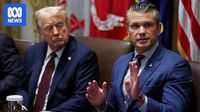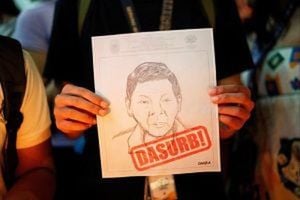On Tuesday, September 30, 2025, the usually quiet town of Quantico, Virginia, found itself thrust into the national spotlight as President Donald Trump joined Defense Secretary Pete Hegseth for an unprecedented gathering of the nation's top military brass. According to The Washington Post, the event, held at the Marine Corps University, brought together hundreds of generals and admirals from across the globe—a move that has raised eyebrows, sparked security concerns, and left many in Washington wondering about the true purpose behind such a rare assembly.
The story began to unfold over the weekend, when a planning document, reviewed by The Washington Post and reported on September 27, confirmed Trump’s attendance at the meeting. The White House, for its part, remained tight-lipped, declining to comment immediately on the president's plans. However, Trump himself broke the silence, telling reporters he intended to address the assembled military leaders with a message of appreciation and resolve. "We love them," Trump said, according to Reuters, adding that he would remind the generals and admirals that they are "cherished leaders who need to be strong and tough."
Behind the scenes, the logistics and implications of the event were anything but straightforward. Defense Secretary Pete Hegseth had, just days earlier, issued orders for hundreds of senior U.S. military leaders—from both domestic and international posts—to converge on Quantico for the meeting. The sheer scale of the gathering was described by The Washington Post as "unprecedented," with military officials and analysts noting that rarely, if ever, had so many high-ranking officers been summoned to a single, publicly known location.
Initially, the purpose of the meeting was shrouded in mystery. Hegseth’s office offered little explanation, fueling speculation across Washington and within military circles. Some wondered whether the event would serve as a forum for major announcements regarding personnel changes, especially in light of Hegseth’s earlier directive this year to reduce the number of four-star general officers by 20%. The timing only stoked these rumors, as the meeting fell on the last day of the federal fiscal year—a period often fraught with budgetary uncertainty and, in this case, the looming threat of a government shutdown.
Security concerns quickly became a major focus. As The Washington Post reported, Pentagon offices were warned that the president’s attendance would "significantly change the security posture" of the event. With so many of the nation’s top military minds gathered in one place, the risk profile was already high. Trump’s decision to join the assembly meant that the Secret Service would take over primary responsibility for event security, layering in additional protocols and precautions. The possibility of a government shutdown added another wrinkle: senior officers flown in for the meeting could potentially find themselves stranded away from their commands if funding lapsed while they were in Virginia.
Despite the swirl of speculation and concern, Defense Secretary Hegseth eventually clarified, at least in part, the intent behind the gathering. According to The Washington Post, Hegseth planned to deliver a brief address focused on new military standards designed to restore what he described as the "warrior ethos." This phrase, evocative of a return to traditional values of discipline, resilience, and combat readiness, has become something of a watchword for Hegseth since his appointment as defense secretary. However, it remained unclear whether President Trump would also take the podium, potentially overshadowing his defense chief’s message.
For many observers, the event’s opacity was as notable as its scale. As of September 29, Hegseth had not publicly articulated specific reasons for convening the generals and admirals, leaving even some attendees in the dark about what to expect. According to Reuters, the lack of clear communication led to unease among military leaders, especially given the recent history of abrupt policy shifts and high-profile personnel changes within the Department of Defense.
Trump’s own comments did little to dispel the uncertainty. While his message of support for the military was unequivocal—“we love them”—he also emphasized the need for strength and toughness among the nation’s top officers. This rhetoric, familiar to those who have followed Trump’s approach to military affairs, was seen by some as a rallying cry and by others as a signal of possible changes to come.
The context of the meeting cannot be overlooked. Earlier in 2025, Secretary Hegseth’s order to cut 20% of the military’s four-star generals had already sent shockwaves through the Pentagon. The move, framed as an effort to streamline the command structure and emphasize operational effectiveness, was controversial from the outset. Critics worried that it could undermine morale or disrupt continuity at the highest levels of leadership. Against this backdrop, the sudden summoning of hundreds of generals and admirals—without a clear agenda—prompted fears that further cuts or demotions might be in the offing.
Yet, as the day unfolded, the gathering at Quantico remained focused on Hegseth’s stated goal: reinforcing the warrior ethos and setting new standards for military leadership. According to those present, the defense secretary’s speech was concise but pointed, emphasizing the importance of unity, discipline, and readiness in a world where American military power is constantly tested. Whether Trump would deliver his own remarks was, as of the morning of the event, still an open question—a fact that only heightened the sense of anticipation in the room.
Observers and analysts quickly drew comparisons to previous presidential engagements with the military. While it is not unusual for presidents or defense secretaries to address senior officers, the scale and public nature of the Quantico meeting set it apart. The logistics alone—coordinating travel, lodging, and security for hundreds of high-ranking leaders—were daunting, and the risks associated with concentrating so much of the military’s leadership in one place were not lost on anyone involved.
As the meeting drew to a close, questions lingered. What, if any, lasting impact would the gathering have on the direction of the U.S. military? Would Hegseth’s push for a renewed warrior ethos translate into concrete changes on the ground? And, perhaps most importantly, would Trump’s presence signal a new chapter in civil-military relations, or simply serve as another headline in a year already marked by political and institutional upheaval?
For now, the answers remain elusive. But one thing is certain: the events of September 30, 2025, at Quantico will be remembered as a moment when the nation’s military leadership stood together—under the watchful eyes of both the president and the public—at a crossroads of uncertainty and change.




